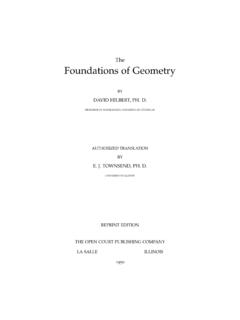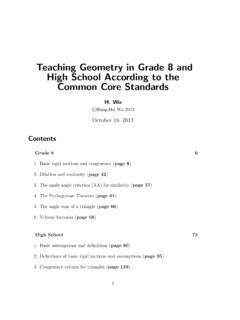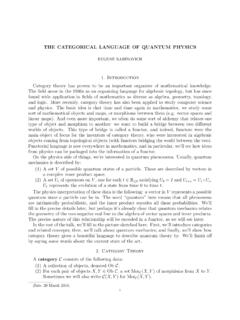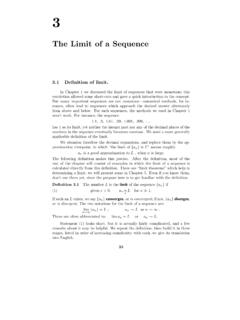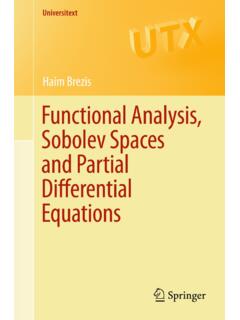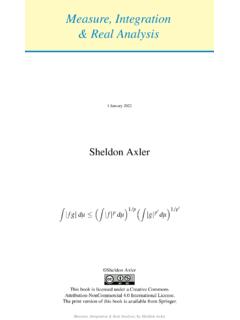Transcription of Solutions to Assignment-1 - University of California, Berkeley
1 Solutions to Assignment-1 . In each of the following, only use (and indicate) theorems or axioms introduced in the lectures.. 1. (a) Show that 12 is irrational.. Solution: If not, then 6 = p/q where p and q have no common factors. Squaring, p2 = 12q 2 . Since 3 divides the right-hand side, it ought to also divide the left hand side, and hence must divide p. So let p = 3m. Then we have 9m2 = 12q 2 or 3m2 = 4q 2 , and so 3|4q 2 . But since 3 is a prime and does not divide 4, we must have that 3|q 2 or 3|q. But then 3 is a common factor between p and q, a contradiction!. Note. One cannot argue using divisibility with respect to 2 (try it!)
2 !) as in the proof of irrationality of 2. (b) Now consider the set E := { Q | 2 < 12}. Given any positive number Q such that 2 < 12, find an explicit rational number > 0 (depending of course on ), such that ( + )2 < 12. Solution: We need an > 0 such that ( + )2 < 12. Note that ( + )2 = 2 + 2 + 2 . Now, since 2 < 12, clearly, < 4. If we then pick < 1, since 2 < , we automatically have ( + )2 < 2 + 9 . Now, if pick smaller than (12 2 )/9, we will have ( + )2 < 12. So we can take 12 2 . < min 1, . 9. (c) Similarly, if 2 > 12, and < 4, find an explicit positive rational number such that ( )2 > 12. and yet is an upper bound of E.
3 Solution: We argue as above, noting that ( )2 = 2 2 + 2 2 8 + 2 > 2 8 , since < 4 and 2 > 0. Since we want this to be greater than 12, we simply choose 2 12. = . 8. This solves the first part. Claim. With as above, is also an upper bound for E. Firstly, note that > 0. So if the claim is false, then there exists a positive E such that . Squaring both sides preserves the inequality since both numbers are positive, and we obtain 2 ( )2 . This is clearly a contradiction, since the left hand side 2 < 12, by the definition of E, while the right hand side by construction is bigger than 12. 1. (d) Hence show that E has no least upper bound in Q.
4 Solution: Suppose = sup E Q. There are three cases. 2 < 12. Then by definition E. By part(b), there exists an > 0 such that + E, and so is not an upper bound for E. A contradiction. 2 > 12. By part(c), there exists an > 0 such that is also an upper bound for E, and so which contradicts the fact that is the least upper bound. 2 = 12. By part(a), this is not possible for a rational number . So all three cases give contradictions, and hence E does not have a supremum in Q. 2. Let a, b R. (a) Show that |b| a if and only if a b a. Solution: Every if and only if proof has two directions. = . So we assume that |b| a.
5 In particular this implies that a 0. We proceed by contradiction. Suppose b > a. Then b > 0, and so |b| = b contradicting the assumption that |b| a. Similarly, if b < a, then b < 0 and so |b| = b, and so b a, or b a which is a contradiction. = . Now we assume that a b a. If b 0, then |b| = b a. If b < 0, then |b| = b. Since b a, b a. So again |b| a. (b) Show that ||b| |a|| |b a|. Solution: By the regular triangle inequality, |a| |a b| + |b|, and so |b| |a| |b a|. Again by triangle inequality, |b| |b a| + |a|, and so |b| |a| |b a|. That is, |b a| |b| |a| |b a|. Then by part(a) above, ||b| |a|| |b a|. 3. Let A, B R.
6 (a) If sup A < sup B, then show that there is some b B which is an upper bound for A. Solution: Since sup A < sup B, there exists a such that sup A < < sup B. But then < . for all A. On the other hand cannot be an upper bound for B, and so there exists b B. such that b. Then this b is clearly an upper bound for A. (b) Show, by providing an example, that this is not necessarily the case if sup A sup B. Solution: Let 1. A = { | n N}, B = [ 1, 0). n Then sup A = sup B = 0, but no element of B is an upper bound for A. 4. Let a < b be real numbers, and consider the set T = Q [a, b]. Show that inf T = a and sup T = b.]
7 2. Solution: We show that sup T = b. Clearly b is an upper bound for T . Suppose is another upper bound, and suppose < b. Then by the density of rationals, there exists a rational r Q such that < r < b. Then r T and cannot be an upper bound. Contradiction! 1. 5. (a) Let a, b R such that a b + n for all n N. Show that a b. Solution: If not, then a > b or equivalently a b > 0. Then by the corollary to the Archimedean property, there exists an integer n such that a b > 1/n, contradicting the hypothesis that a b + n1 for all n. Hence we must have that a b. 1. (b) Show that if a > 0, then there exists a natural number n N such that n a n.
8 Solution: By the Archimedean property, there exist natural numbers n1 and n2 such that 1. < a and a < n2 . n1. Now let n = max(n1 , n2 ). Then 1/n 1/n1 and n n2 , and so 1. a n. n (c) Let a, b R such that a < b. Use the denseness of Q to show that there are infinitely many rationals between a and b. Solution: By the density of Q, there is at least one rational number in (a, b). Call this r1 . Then again by density of rationals, there is at least one rational in (r1 , b); call this r2 . Having picked r1 , r2 , , rn , let rn+1 be a rational number between (rn , b). So we have an infinite collection of rationals r1 , r2 , between a and b.
9 6. Let A and B be non-empty subsets of R, and let A + B := {a + b | a A, b B}. That is, A + B is the set of all sums a + b, where a A and b B. (a) Show that sup(A + B) = sup A + sup B. Note. You need to separately consider the case when at least one of the two supremums on the right is . Solution: Let sup A = and sup B = . Suppose , < . Clearly + is an upper bound for A+B, and so sup(A+B) + . Next, for any > 0, there exists an a A and a b B such that . a , b . 2 2. So there exists a + b A + B satisfying a + b + . Taking supremum, sup(A + B) + . Since this is true for all > 0, we must have sup(A+B) + and so sup(A+B) = +.
10 Suppose = . Then A is unbounded, and so must A + B. = . Same argument. 3. (b) inf(A + B) = inf A + inf B. Solution: Follows from the facts that inf E = sup( E), (A+B) = A+( B), and part(a). above. 7. For each sequence , find the limit, and use the definition of limits to prove that the sequence does indeed converge to the proposed limit. Note that this means, given an > 0, you need to write down an N for which the definition of convergence works. Try to make the dependence of N on as explicit as possible. 3n + 1. (a) lim . n 6n + 5. Solution: Discussion. (3n + 1)/(6n + 5) = (3 + 1/n)/6 + 5/n. As n , clearly this should tend towards 3/6 or 1/2.
